IJCRR - 7(12), June, 2015
Pages: 07-14
Print Article
Download XML Download PDF
DEMOGRAPHIC FACTORS INFLUENCING CONSUMERS' LIFE STYLE ON MOBILE PHONE USAGE: A CASE OF DILLA CITY, ETHIOPIA
Author: Genet Gebre Tirfe, Rajyalakshmi Nittala
Category: Healthcare
Abstract:Mobile phones enable people to keep in touch with their families and friends. It makes easy the day to day activity of peoples around the world. The aim of this research is to investigate demographic factors influencing consumers' life style on mobile phone usage in Dilla City, Ethiopia. This study evaluates the effect of demographic factors specifically consumers' age, education, income, and occupation on mobile phone usage. The research methodology used in this study is both qualitative and quantitative approaches. 381 customers were surveyed by using purposive sampling technique. The target population of the study included businessmen, employees in government offices, teachers, and students. Primary data was collected through structured questionnaire. Secondary data were gathered from books, research studies, various governmental and nongovernmental organizations reports, and on line resources. Descriptive statistics and One-Way Analysis of Variance was employed to
analyze the data. The results of the study revealed that significant difference exist between life style on mobile phone usage and consumers' occupational status and monthly income. On the other hand, the research found out that life style on mobile phone usage was not varied by age group and educational level of respondents. The research concluded that consumers' make their purchase decisions by evaluating their life style and demographic factors in mobile phone usage. Hence, the findings of the study provided that companies and manufacturers need to consider demographic factors that affect mobile phone usage in order to meet the current demand of consumers in Dilla.
Keywords: Demographic factors, Mobile phone, Life style, Consumer behavior, Dilla city
Full Text:
INTRODUCTION
The cell phone’s popularity revolves around convenience, business, recreation, and safety (Patel and Singh, 2011). The various information services of the cell phone have created an environment of immediate communication which has produced economic benefit to business and society. This makes the device very important in day to day activity (Moklis and Yaakop, 2012). Many of the phones have several applications such as calling, texting, and listening to music (Das, 2012). Patel and Singh (2011) further studied that mobile phone usage pattern varies from one group to another. Recreationally, cell phones have become entertaining devices for not only communication, but also for music and video activities, color screen, camera, and games (Safik and Azizul, 2012). Besides, (Wiliska, 2003) stated that young people relationship with their mobile phone is consistent with their life style in terms of technology enthusiasm. Mobile phone service applications are enormous attraction especially to young consumers who are constantly changing their interests with new innovative features. On the other hand, Chaubay, Zafar, Hassen (2011) described in their study that cell-phone connection is considered as an important mechanism for connecting family and friends. Coogan and Kangas (2001) also explained that a cell phone is also a symbol of belonging to a group and a part of one’s identity. Young people need cell-phone technology to establish and maintain social networks which help in their social interactions and other new dimensions in their lives (Downs and Aoki, 2003). Jaysingh and Eze (2009) highlighted that in their study that the universal availability of wireless telephony provides new business opportunities. Thus, it can be inferred that mobile phone usage varies considerably between the socioeconomic variables explained above. Moreover, Engel et al. (1995) suggested that an important part of lifestyle marketing is to identify the set of products and services that consumers associate with a specific lifestyle. Marketers need to understand the activities, interests, and opinions that influence life style of consumers, since they often attempt to influence consumer purchasing behavior through life style marketing. Marketers also need to relate a product to everyday experience of the target consumers by depicting how a specific product can be used by different age, income, occupation, and educational groups. Dilla’s importance as a market center grew especially for its coffee market after the mid-1920s. It is the administrative center of the Gedeo Zone in the Southern Nations and Nationalities, and Peoples Region. The city is located on the main road from Addis Ababa the capital city of Ethiopia to Nairobi. The city is the major transfer and marketing point for coffee grown farther south, particularly of the much-prized Yirga-Cheffe varietal1 . Central statistical agency of Ethiopia (2014) estimated that the total population of Dilla city is 125,599 out of which male account 63,360 and female constitute 62,239. Infrastructure problems slow down the socio-economic development of the town. According to Dilla structure plan project draft (2012) the most important means of transport is road transport. The existing road network in Dilla is insignificant in relation to the size and area of the city. This has been one of a great challenge in the development of communication technology. Besides, mobile phones’ marketing is low as compared to the development of commercial activities of the city. The growing need for modern communication technology devices in each sector of the economy calls for more research in Dilla as well as in Ethiopia. Hence, considering mobile phone as one of the telecommunication services, the current study explores demographic factors influencing consumers’ life Style on mobile phone usage in Dilla city.
Objectives of the study
- To identify demographic factors influencing consumers’ life style on mobile phone usage
- To examine life style factors that affect consumers’ mobile phone usage.
LITERATURE REVIEW
Ling and Yittri (2002) study revealed that adolescents used the mobile phone for emotional and social communications specifically in building and sustaining relationship with friends. Furthermore, their study found that adolescents viewed mobile phone as an outstanding, prominent, and liberating personal tool that allows them to have a better social position in life. Their further investigation disclosed that individuals with high self esteem understood to use less of the mobile phone for communication compared to those with low self esteem. Low self-esteem users were assumed to use mobile phone for reassurance and not mainly for social purposes. Chaubey, Zafar, and Hasan (2011) in their research also observed that different factors affecting customers’ decision of mobile service providers are associated with their level of education and income. Karjaluoto et al. (2005) added that students are buying low-priced phones. Some groups regarded new technological features such as multimedia messaging service (MMS) handy but too expensive to use at present. College students’ use of mobile phone for a variety of purposes was studied by Aoki and Downes (2003). The study found out that mobile phone helps them to feel safe, financial benefits or to manage time efficiently, keep in touch with friends, and family members. Moreover, the Brtish education communication technology agency (2008) highlighted that the multi-tasking capabilities by young people who are exceptional mobile game players. Juwaheer, Pudaruth,, Vencatachellum, Ramasawmy, and Ponnusami (2013) also found that mobile phone features and young consumers’ lifestyle impacted mobile phone selection. In another study, Wilska (2003) found that mobile phone choice and especially usage is consistent with respondents’ general consumption styles among Finnish young people aged 16-20. The research showed that addictive use was common among females and was related to trendy and impulsive consumption styles. On the other hand, males were found to have more technology enthusiasm and trendy-consciousness. These attributes were then linked to impulsive consumption. The study concluded that genders are becoming more alike in mobile phone choice. Similarly, Kumjonmenukul (2011) found out that factors that determine the selection of mobile phone by young people include touch screens, built-in cameras, and mp- 3capabilities. Style of ringtones on offer with the phone, the colors of mobile phone model available, chat or mobile internet application considered as important factors that affect mobile choice of young consumers. Ozcan and Koçak(2003)studies showed that income, previous experience with cellular phones, brand of handset, and use at the workplace and in car are found to be important in determining the level of usage. On the other hand, Patel and Rathod (2011) conducted a study on mobile phone usage habits of students in the rural areas of Visnagar by emphasizing on different influential factors affecting mobile purchase. The result of the study revealed that mobile phone has been largely accepted by students pursuing their graduation.
Conceptual frame work
The various studies discussed above identified important points in understanding demographic factors that are involved in consumers’ life style of mobile phone usage. The detail discussion above also suggested that companies to consider demographic factors of consumers in production and mobile phones marketing. A conceptual frame work for this research (see figure1) is developed based on the research work of Juwaheer, Pudaruth, Vencatachellum, Ramasawmy, and Ponnusami, ( 2013) to show the effect of demographic factors on life style of mobile phone usage.
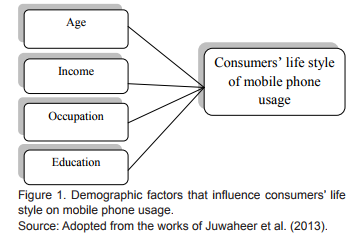
RESEARCH METHODOLOGY
This section describes the research plan for this study and the way in which the research was conducted. The research sample, research methods, research instruments used to collect the data, and the method of distribution of questionnaire. Techniques of data analysis including methods used to maintain validity and reliability of the instrument are also explained. The research employed a descriptive research design for this study. Descriptive research describes behavior, attitudes, values, and characteristics (Kothari, 2004). It was found to be appropriate for this study because the purpose of the study was to investigate demographic factors that influence consumers’ life style on mobile phone usage. The target population included business men, teachers, employees in government office, and students. Effort was made to collect data from 400 consumers by using purposeful sampling technique. However, 381 qualified questionnaires were returned. The instrument used for data collection in the form of a structured questionnaire was designed to obtain information on demographic factors and life style of consumers in usage of mobile phone. The questionnaire had a mix of close-ended and open-ended questions in it. The first part was related to the demographic factors of consumers while the rest included factors related to life style of mobile phone usage such as keep in touch with family and friends, entertain with multimedia, connect people with social net works, update with current technology, and internet operation anywhere. This section contains some subsections on relevant aspects. The subsection is supported by some statements. Respondents’ responses were taken in the form of 5-point Likert scale as 1 for strongly disagree, 2 disagree, 3 neutral, 4 agree, and 5, strongly agree respectively. The open ended questions also assist the study in understanding the demographic factors that affect consumers in mobile phone usage. Consumers’ life style factors for usage of mobile phone were selected from the study conducted by Juwaheer, Pudaruth, Vencatachellum, Ramasawmy, and Ponnusami (2013) keeping in view of their importance to mobile phone usage in Dilla city. In order to achieve the objective of this research, One-Way Analysis of variance was used for data analysis. This method was selected to identify the demographic factors that affect consumers’ life style on mobile phone usage. Table 1 below illustrates the demographic characteristics of respondents.
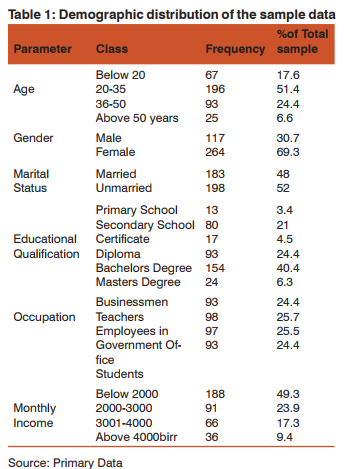
Table 1 above indicates that sample customers in all age groups are users of mobile phones. However, age group 20-35 consists of the highest percentage (51.4%) of users compared to others. On the other hand, the table shows that the least number of respondents above 50 years are (6.6%). The majority of the respondents are females (69.3 %); and unmarried respondents represent (52%). Besides, sample respondents who posses’ bachelors’ degree level are (40.4%). The least number of respondents (4.5%) and (3.4%) are in certificate and primary level of education. The table also shows that according to occupational status, the number of respondents in each group is similar. Besides, (49.3%) samples respondents are within income group of below2000ETH birr. While, (9.4%) of respondents earn monthly income of above 4,000ETHbirr.
Hypothesis
We use mobile phones in our everyday life and for entertainment regardless of our age, occupation, income, or education. Consumers’ behavior is influenced by demographic factors, which include buyers’ age, occupation, income, and education. Products and brands are also perceived by consumers as having symbolic meaning (Loudon and Della Bitta, 1993). The profession or the occupation a person is in again has also an impact on the products they consume. Thus the following hypothesis was developed.
H1: Consumers’ life style in usage of mobile phone is different by consumers’ age, income, occupation, and educational level.
DATA ANALYSIS AND DISCUSSION OF RESULT
Reliability and validity of data
This section describes the reliability of instruments used in the research. Item total correlation applied in this study to investigate the validity of instruments. Item total correlation has been employed in this study to evaluate whether the factors under life style measure the same construct. Factors which have correlation coefficient of below.3 have been omitted (Pallant, 2005). Table 2 below illustrates the reliability analyses related to consumers’ life style factors in mobile phone usage.
The content validity of the questionnaire was assessed through examination by experts in the area. Initial changes were made to clarify or delete some statements according to recommendations or comments of the experts. A pilot survey was also conducted with 24 customers from each occupation i.e., business men, teachers, employees in government office, and students prior to the data collection in terms of vague questions and wordings. Few modifications were made to avoid misunderstanding among respondents
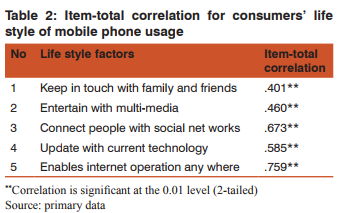
Table 2 depicted that life style factors in usage of mobile phone such as helping to keep in touch with family and friends, entertain with multi-media, connect customers with social net works, keep up to date with current technology, and enables internet operation anywhere. Thus, the results in the table revealed that items stated under life style are acceptable.
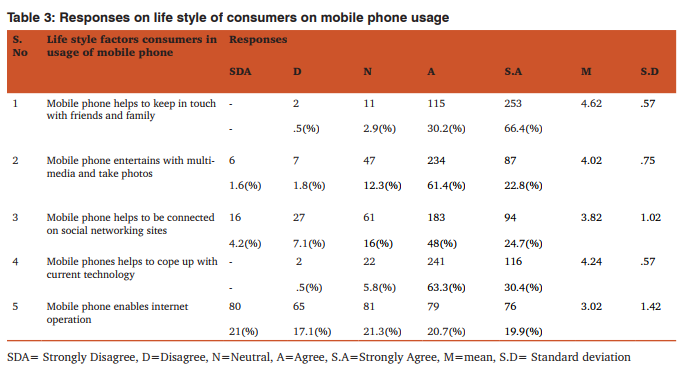
Table 3 above indicated that 96.4 percent of respondents agreed or strongly agreed that mobile phone helps them keep in touch with family and friends (M=4.62 and S.D=.57); Similarly, 93.7 percent of respondents agreed or strongly agreed that advanced functions in mobile phones makes them to cope up with current technology (M=4.24 and S.D=.57). Likewise, 84.2 percent of respondents agreed or strongly agreed that mobile phone helps them to entertain with music, games, and video (M=4.02 and S.D=.75). Moreover, 72.7 percent of the sample respondents agreed or strongly agreed that mobile phone helps them to be socially connected on social networking sites (M=3.82 and S.D=1.02). On the other hand, 40.6 percent of respondents agreed or strongly agreed that mobile phone enables them internet operation anywhere (M=3.02 and S.D=1.42). Therefore, the results of the study above shows that consumers life style factors such as use of mobile phone for keeping in touch with family and friends (96.4%), advanced functions (93.7%), entertainment with multimedia and photos (84.2%), and getting socially connected on social networking sites (72.7%) significantly affected consumers behavior toward mobile phone usage. On the contrary, for the factor mobile phone enables internet operation anywhere (40.6%) does not significantly affect consumers’ behavior toward mobile phone usage as compared to other factors.
Table (4-7) below is constructed to investigate consumers’ life style differences on mobile phone usage for various purposes by ages, occupation, income, and educational level of respondents. In order to investigate life style differences in usage of mobile phone by these factors One-Way-ANOVA analysis was used.

One-Way-ANOVA in table 4 shows that sample respondents’ occupational status, mean, standard deviation, and results of life style differences on mobile phone usage. The sample respondents’ occupational status is business men, teachers, employee in government office, and students. The mean and standard deviation in usage of mobile phone for business men is (M=3.42, S.D=.61); Teachers (M=3.94, S.D=.57); Employee in government office (M=4.05, S.D=.60); Students (M=4.11, S.D=.65). The results of ANOVA table in table 4 above shows that there is significant life style differences in usage of mobile phone in the mean scores across the four occupational status groups at p<.05 level as [F (3, 377) =6.60, p=.000].
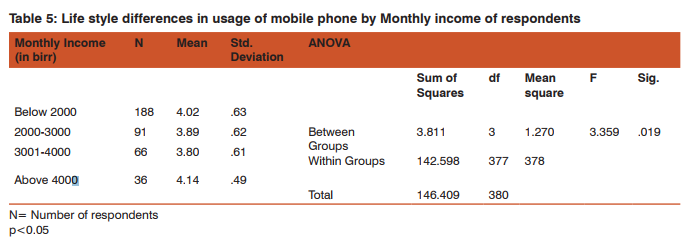
Table 5 above indicates sample respondents’ monthly incomes, mean, standard deviation, results of life style differences in usage of mobile phone between different income groups. The sample respondents’ monthly income ranges below 2000ETH birr; 2000-3000 birr; 3001-4000 birr; and above 4000 birr. The mean and standard deviation of life style in usage of mobile phone for income groups are: below 2000 birr (M=4.02, S.D=.63); 2000-3000 birr (M=3.89, S.D=.62); 3001-4000 birr (M=3.80, S.D=.61); above 4000 birr (M=4.14, S.D=.49). The results of ANOVA in table 5 shows that there is significant differences in life style in usage of mobile phone in the mean scores across the four income groups at the p<.05 level as [F (3, 377) =3.36, p=.019].
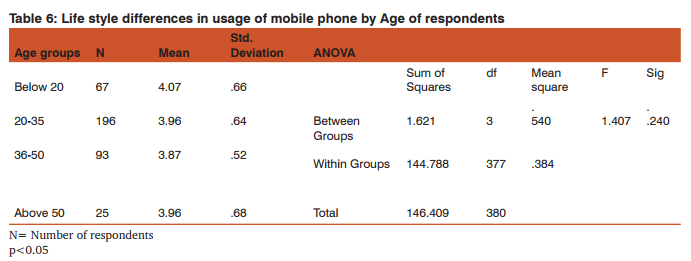
Table 6 illustrates that sample respondents’ ages, mean, standard deviation, and results of life style differences in usage of mobile phone with different age groups. The sample respondents’ ages are: below 20, 20-35, 36-50, and above 50. The mean and standard deviation for these age groups are: below 20 (M=4.07, S.D=.66); 20-35(M=3.96, S.D=.64); 36-50 (M=3.87, S.D=.52); above 50 (M=3.96, S.D=.68). The results of ANOVA in the table above shows that there is no significant difference in life style in usage of mobile phone in the mean scores across the four age groups at p<.05 level as [F (3, 377) =1.41, p=.240].

Table 7 above indicates that sample respondents’ educational level, mean, standard deviation, and results of life style differences in usage of mobile phone. The sample respondents’ educational level ranges from primary school up to Masters Degree holders. The mean and standard deviation for these educational level are primary school (M=3.69, S.D=.75); Secondary School (M=3.89, S.D=.66); Certificate (M=3.76, S.D=.66); Diploma (M=4.04, S.D=.62); Bachelor Degree (M=3.99, S.D=.60); Masters Degree (M=4, S.D=.42). The results of ANOVA in table 7 shows that there is no significant differences in life style in usage of mobile phone in the mean scores across the six educational level groups at p<.05 level as [F (5, 375) =1.46, p=.203]. Different studies supported the research findings discussed in table (3-7) above. Chaubay, Zafar, Hassen (2011) found out that cell-phone connection is an important device for connecting family and friends; Lee, Lim, Jolly, and Lee (2009) pointed out in their study that the importance of selecting mobile phones which matches customers’ lifestyles. On the other hand, Banumathy and Kalaivani (2004) suggested in their study that service providers have to introduce the cellular phones which are economical to the low income group people. Karjaluoto et al. (2005) revealed in their study that professions in middle or top management of various companies value enhanced data and networking features significantly higher than students and employees that perform tasks on the operational level in manufacturing or service industries. The only exception is the design, which is considered equally important between employees that perform tasks on the operational level in manufacturing or service industries workers and students. In contrast, the findings of the current research do not indicate that life style differences in usage of mobile phone by different ages and educational qualifications. This result is different from the previous works of Ling (2001) who found that young adult men spent more time on mobile phones as compared to adolescent girls; Ling and Yittri (2002) study results showed that Adolescents used the mobile phone for emotional and social communications specifically in building and sustaining relationship with friends. Furthermore, Zulkefly and Baharudin (2009) found that age of the students also played a factor in determining patterns of using mobile phones. Therefore, the research findings above support as well as presented different result from the current study. The research results above support the current study in such a manner that there are life style differences in usage of mobile phone especially for different occupational and income groups. On the other hand, the current study findings is different from the research studies above in that it doesn’t show life style differences in usage of mobile phone for various purposes for different age groups and educational levels.
CONCLUSION
The research was carried out to investigate demographic factors influencing consumers’ lifestyle on mobile phone usage in Ethiopia, Dilla city. This study contributes to the knowledge of consumers’ life style in product usage is affected by demographic factors such as income, and occupational status of consumers. The research also suggests that consumers make their purchase decisions on the basis of their evaluation related to their life style on mobile phone usage such as keep in touch with family and friends, entertainment, social networks, update with current technology, and internet operation anywhere and their demographic characteristics. The qualitative result of the study revealed that among different reasons consumers prefer to use mobile phone for keeping in touch with their family and friends. On the other hand, based on the findings of (Juwaheer et al., 2013 and Karjaluoto et al., 2005) the quantitative results of the study found out that significant difference between monthly income and occupational status of consumers and life style on usage of mobile phone. However, the current research findings indicated that life style on mobile phone usage was not varied by age and educational level of respondents which is different from previous studies of Ling (2001); Ling and Yittri (2002); and Zulkefly and Baharudin (2009). Therefore, manufacturers and dealers in Dilla city achieve their future marketing strategy best if they take in to account various application services related to mobile phone use and demographic factors of consumers. Despite this study provides an insight based on major services of mobile phones and consumers’ demographic factors that influence mobile phone usage in Dilla City. Besides, this research is an attempt on consumers’ behavior toward mobile phone usage and certain limitations concerning the research setting should be suggested to guide future research. Hence, the study used purposive sampling technique which is not totally free from bias. The study was also conducted in Dilla City with business men, teachers, employees in government office, and students. Future research may focus to validate the current result by using probability sampling technique encompassing more customers from other cities of Ethiopia. Further investigation may be required by focusing on other aspects of demographic factors.
ACKNOWLEDGEMENT
We express my sincere gratitude to Ministry of Education, Hawassa University, Ethiopia for financial support to carry out this research. We are thankful to Hawassa University School of Management and Accounting administration and staffs, Ethio telecom employees, Dilla primary and secondary schools, Dilla University staffs and students, governmental and nongovernmental organizations for their co-operation to undertake this research. Authors of this research acknowledge the immense help received from the scholars whose articles are cited and included in references of this manuscript. We are also grateful to authors/editors/ publishers of all those articles, journals, and books from where the literature for this article has been reviewed and discussed.
References:
1. Aoki, K., and Downes, E. (2003). An analysis of young people’s use of and attitudes toward cell phones. Telematics and Informatics, 20(4), 349-364.
2. Banumathy, S, and Kalaivani, P. (2004). Attitude of customers towards Cell phones. M.Phil.Dissertation, Madurai Kamaraj University, Madurai.
3. Brtish Education Communication Technology Agency. (2008). Analysis of emerging trends affecting the use of technology in education [online]. Research Report, Available from: http://dera.ioe.ac.uk/1538/1/becta-2008-ht consolidated _trends _1of4_report.pdf Accessed on [24 September 2011].
4. Chaubey, D.S., Zafar, S.M., T., and Hassen, S.M. (2011). Mobile phone users’ behavior and service uses: A study of consumers of Uttrakhand state. Annals of Management Research, 1(1), 1-21.
5. Das, Debadutta.(2012). An empirical analysis of consumer buying behavior towards mobile hand set as a means of processing information. PARIPX, Indian Journal of Research,1(9),107-111.
6. Dilla Structure Plan Project,Draft. (2012). Ethiopian Civil Service University, Addis Ababa.
7. Engel, J.F, Blackwell,R.,and Miniard,P. (1995).Consumer behavior (8th ed.). Chicago: The Dryden press.
8. Jaysingh,S., and Eze, U., C. (2009). An empirical analysis of consumer intention toward mobile coupons in Malaysia. International Journal of Business and Information,4(2),221-242.
9. Juwaheer, T., D., Pudaruth, S., Vencatachellum, I., Ramasawmy, D., Ponnusami, Y. (2013).Factors influencing the selection of mobile phones among young customers in Mauritius. International Journal of Advanced Research, 1 (4), 326-339.
10. Karjaluoto,.H., Karvonen,J., Kesti, M., Koivumäki,T., Pakola, J., Ristola, A., and Salo, J. (2005). Factors affecting consumer choice of mobile phones: Two studies from Finland. Journal of Euro marketing, 14(3), 59-82.
11. Kothari, C.R. (2004). Research methodology, methods and techniques (2nd ed.). New Delhi: New Age International publishers.
12. Kumjonmenukul, P. (2011). The behavior of young people when using mobile phones and its impact on Thai culture and lifestyle: A case study of Kalasin Municipality in Kalasin province. American Journal of Scientific Research, 22, 57-64.
13. Lee, H.J., Lim, H., Jolly, L.D. and Lee, J. (2009). Consumer lifestyles and adoption of high-technology products: a case of South Korea. Journal of International Consumer Marketing, 21 (3), 153-67.
14. Lim, E. A. C., and Ang, S. H. (2008). Hedonic vs. utilitarian consumption: a cross-cultural perspective based on cultural conditioning. Journal of Business Research, 61, 225-232. http://dx.doi.org/10.1016/j.jbusres.2007.06.004.
15. Ling, R. (2001). Students girls and young adult men: Two sub-cultures of the mobile telephone. (R and D report. No.34). Kjeller: Telenor Research and Development.
16. Ling, R. and Yittri, B. (2002). Hyper-coordination via Mobile Phones in Norway. In J. E. Katz and M. Aakhus (Eds.), Perpetual Contact: Mobile communication, Private Talk, Public Performance. Cambridge:Cambridge University Press, 139-169.
17. Loudon, D.L., and Della Bitta, A.J. (1993). Consumer behavior, concepts and application (4th ed.) New York: McGraw Hill.
18. Mokhlis, S. and Yaakop,A.Y.(2012). Consumers choice criteria in mobile phone selection: An investigation of Malaysian University students. International Review of Social Sciences and Humanities, 2,(2),203-212.
19. Oksman, V. and Turtiainen, J. (2004). Mobile communication as a social stage: Meanings of mobile communication in everyday life among teenagers in Finland. International Journal of advertising, 26(2),223-246, New Media and Society, 6(3), available at http://www.new-media-and-society. com.
20. Ozcan, Y.Z., and Koçak, A. (2003). A need or a status symbol? European Journal of Communication, 18(2), 241-254.
21. Pallent, J.(2005). SPSS Survival manual: A step by step guide (2nd ed.). Austria: Allen and Unwin.
22. Patel, A., and Rathod, H. S. (2011). Mobile phone usage habits of students commuting from rural areas to nearby town - an exploratory study of Visnagar (Gujarat-India). Global Journal of Management and Business Research, 11 (6), 30-38.
23. Safiek, M., and Azizul, Y.,Y.(2012).Consumer choice criteria in mobile phone selection: An investigation of Malaysian University students. International Review of Social Sciences and Humanities, 2(2), 203-212.
24. Wilska, T-A. (2003). Mobile phone use as part of young people’s consumption styles. Journal of Consumer policy, 26 (4), 441-463.
25. Zulkefly, S. N., and Baharundin, R.(2009). Mobile phone use amongst students in a university in Malaysia: It’s correlates and relationship to psychological health. Open Journal of Scientific Research, 37, 206-218.
26. http://en.wikipedia.org/wiki/Dila,_Ethiopia Accessed on [5 April 2015].
|






 This work is licensed under a Creative Commons Attribution-NonCommercial 4.0 International License
This work is licensed under a Creative Commons Attribution-NonCommercial 4.0 International License